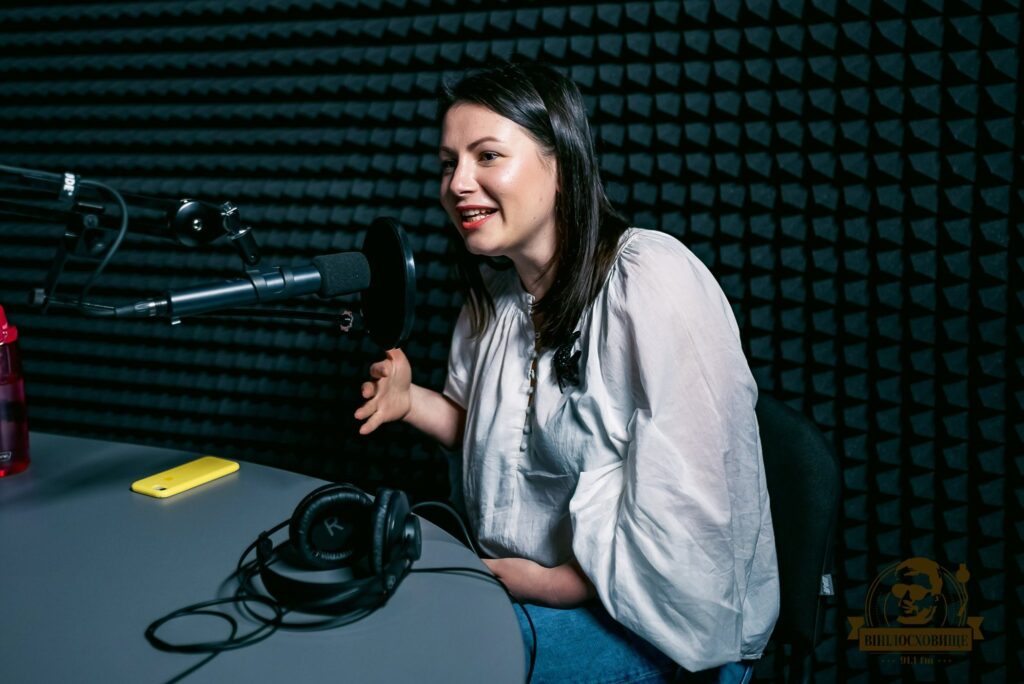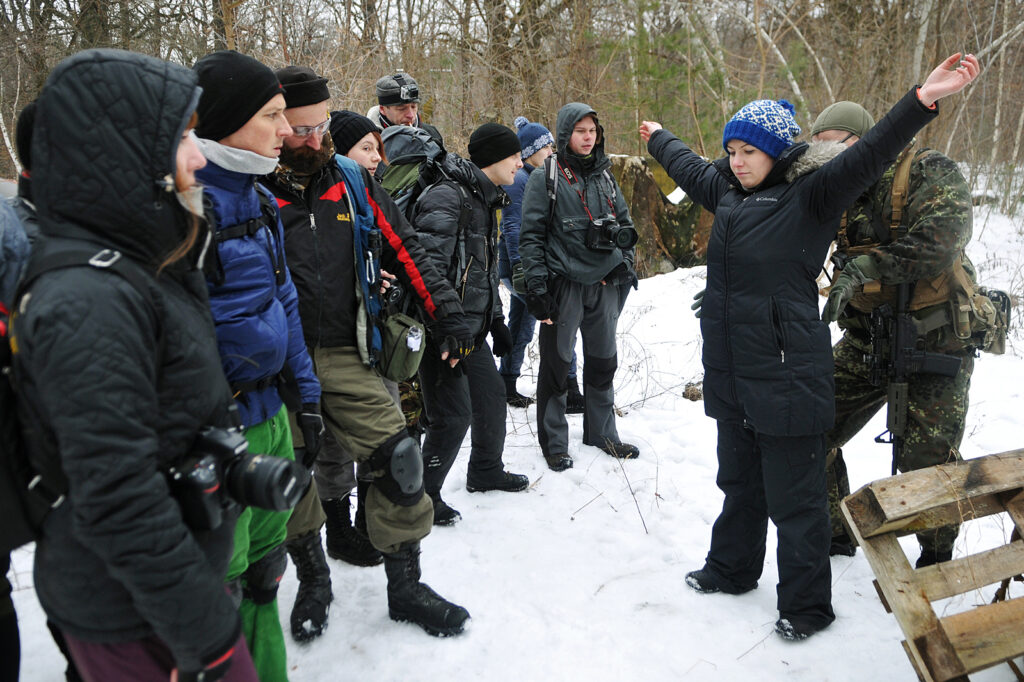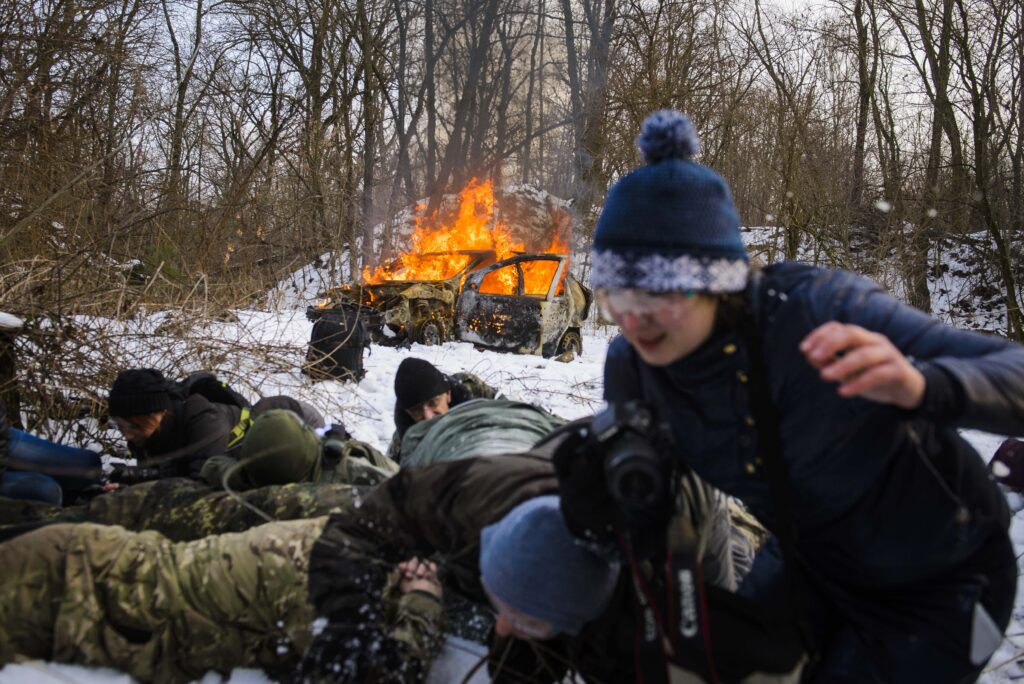An interview with Iryna Zemlyana, an expert on journalist security who coaches Ukrainian war reporters and fixers

Before 2014, Iryna worked as a media expert at the Kyiv-based Institute of Mass Information. After the Euromaidan protests broke out, journalists started to ask her for advice. “When the war started, nobody was ready for that, including the journalists. They did not have bulletproof vests and they did not know how to wear them. One of the journalists came and started to take off the bulletproof jacket that he had borrowed from us in a way that could have broken his neck and could have killed him. I told him how to take it off, and then other journalists started to come and ask me for advice.” She did not know the answers, so she started reading about safety for journalists and taking hostile environment training, and gradually became a recognized expert on the issue.
She has written two how-to books on security for journalists. “One of them focuses on war zone security: risk assessment, planning, clothes, medical instructions, and addresses all the tiny details. For example, that it’s better to go to the dentist before you go to the war zone, that you need to be wearing five layers when it is cold, and that it is better to have a pencil than a pen because the pen can stop working when it’s dirty and cold. The book also covers ethics: how to speak with soldiers and write about the sides of the conflict – that you cannot directly quote separatists because they are not legal – and what you can show.” Her second book focuses on journalists’ safety during protests, elections, and everyday situations.
As a safety instructor, Iryna has trained hundreds of Ukrainian journalists and fixers. The Institute of Mass Information (IMI), funded by non-governmental foundations and contributions from citizens, offers the training for free.
What does your work as a specialist on journalist safety at the IMI involve?
The first part of my job is to provide expertise and advice to journalists about the situation. For example, when Covid started, we needed to analyze the new situation. I also write articles about safety for our website called Jmama: “Journalists’ Mother.” And the third part is safety training. We started with it in 2014 and were really active until 2016, 2017. We trained about 250 journalists, organized two-day, three-day, and five-day pieces of training for journalists.
After the most active part of the war, we realized that everyday security is important too. There was a gathering near the parliament in Kyiv with grenades and lots of people injured, including journalists, so we started to talk more about safety in daily life. And when in spring 2021 there was the buildup of Russian troops on the Ukrainian border, journalists realized that they haven’t refreshed their safety training. So we started to do it again. We have had three training sessions and will have two more. There is a whole new generation of journalists who do not have the safety training but already work as journalists.
What topics do you cover in the safety training?
The three-day training starts with a theory, we talk about risk assessment. A lot of journalists think that they do not need it and will fix it when it happens. We talk about how to prepare, what to bring, and about ethics. On the second day, we provide paramedic training. And on the third day, we do simulations of all that can happen in the warzone. What to do when a sniper starts shooting at you, when there is shelling, how to pass through checkpoints.
We also have a stress test where we imitate bombing, explosions, smoke, Kalashnikovs. The trainees have to be on the ground, hide and sit there until the end. The final stress test takes only about five minutes, but they experience it as two hours. Recently a journalist had a panic attack, started crying, and couldn’t breathe. I was really shocked because she had had extensive experience in the war zone and Crimea. But I myself had gone through nine training sessions yet during a stress test, after a simulated explosion when I had artificial blood on my arm, I was not even able to use a tourniquet.

How can the stress test help?
Journalists need to understand how they would react in these situations. If they have a panic attack while knowing that it is just training and that we use [explosive training] grenades with corn, we ask them to think carefully about whether they really want to go there. So we are helping them to understand how they react and what they could do. Sometimes they just need more training, sometimes they decide not to go to the war zone at all. We had these precedents as well. Some of the journalists realized that it is not for them. In the end, about 30 percent of our students do not go to the war zone.
Before, everyone wanted to go there, and there were also these people that we call “tourist journalists” who just wanted to see the war. Now, it is rather specialist journalists, those who are covering the war on a long-term basis. And the fixers.
Is eastern Ukraine specific in terms of risks that you can encounter there?
It is similar to other wars. But when we started working on safety, we tried using international and safety protocols. For example, the BBC protocol says that if you go to a war zone, you need to have an expert on security, a producer, a cameraman, and the journalist. And you need to have an armored car. But in Ukraine, it is just one journalist with a camera, and he or she goes to the war zone with a tiny car. In 2014, 2015, they even had no bulletproof vests, they were using ours. So it is not the same in terms of support that the journalists have.
A lot of journalists were kidnapped in 2014, 2015, because the frontline was moving. But now it is more stable, so kidnapping is not typical anymore. It is more typical to get injured.
Mental health risks meet financial insecurity
After I told Iryna about the Fixers and Stringers research project and my interest in emotions in journalistic work, she told me about the worrying – and growing – rates of depression and PTSD among Ukrainian freelance journalists and fixers who go to the front line repeatedly or spend long periods of time “there.”
What is the scope of PTSD among Ukrainian journalists?
We did a survey on freelancers in 2017 on how they felt, and we repeated it in 2019. We had a list of depression symptoms and asked which symptoms that may indicate depression they had. In 2017, 75 % of journalists had symptoms of depression, while in 2019 the number was 97 %. We also asked whether they wanted to visit a psychologist. In 2017, 59 % of freelance journalists said that they would like to receive psychological help because of the challenges associated with their professional activities, and this number got also higher in 2019.
How do you explain this change, given that there were more casualties in the earlier phases of the war?
I guess that the journalists were in a process and they did not understand what was going on. And second, in 2015 or 2017, nobody was talking about self-care and psychological problems. After that, we started to talk about it and to name it. Also, in the past, they only started being unable to sleep, and it went on. Three years after, they still experienced the same thing, so they recognized it as a problem.
Some of the journalists worked at war and then formally closed the topic and started living a normal life. And now, if something reminds them of the past, it triggers the PTSD symptoms. For example, after an activist was killed in Kherson in 2018, lots of journalists started to have the symptoms. Also, when fellow journalists get into trouble, it triggers psychological problems.
The survey was focused on freelancers. Is the situation different for staff journalists and fixers?
Yes. The staff journalists have some control over how long they stay in the war zone. But freelancers organize their time themselves. So some of them stayed in the war zone for half a year. And when I ask why, they say, oh, I was just helping the boys with cooking. The soldiers. And then it’s very difficult for them to come back to real life.
So they are staying there in between the assignments?
Yes, or they are just finding assignment after assignment. They do not take a break. It is very important. It is the same problem for fixers. And also, it is not just about self-organization. It is about the money. When they do not know when the next assignment comes, they have to work. So it is a very tricky situation because of both psychology and money.
And what about physical safety? Is it different for staff reporters, freelancers and fixers?
It is not that different, but if a fixer works for a foreign media crew and the people on the frontline do not like the media, the fixer can get into trouble. It can happen to local journalists too. But of course, fixers need to risk more because they cannot decide for themselves. Do they want to go there? No, they have to.
It also depends on the safety protocols of different media. But if the foreign media come here for a short period of time, they always need to see more, to go deeper and to risk more.

“I became very cynical”
Do you also learn from the training?
I have learned a lot and understood a lot of things. I also have my own experience with perhaps not PTSD, but with burnout. For example, during shelling, the rule is to put a person who is already injured on you, to save your life. Or if you see a heavily injured person, you don’t help at all. It is really hard to process these things. I also had a problem with sleeping and I would often cry. One day, it just stopped and I became very cynical. I also know all the journalists’ stories, they just say it. And I can’t say that I do not want to listen to that. I have to listen to that, and can’t do anything about it. Perhaps we can talk about secondary trauma.
I know what you mean. How did you get out of it?
I need to understand what is happening, and why. I started working with a psychologist. Because at some point, I didn’t see my friends’ problems unrelated to the war as problems. So I would say, it’s not a problem, stop crying. But now it makes sense to me, why I was thinking in this way, and I am able to analyze and understand the processes in my head. And now I can also understand where my work is, and where my personal life is. Before, the border was blurred. But this is also because it is happening in my country. In the early phases of the war, we couldn’t even love because we had the war and everything was very serious. But now, with time, it is easier to separate it. Before the pandemic, I had the rule that I didn’t work at home, but since the beginning of the pandemic, it has been impossible to stick to it.
